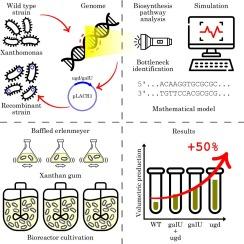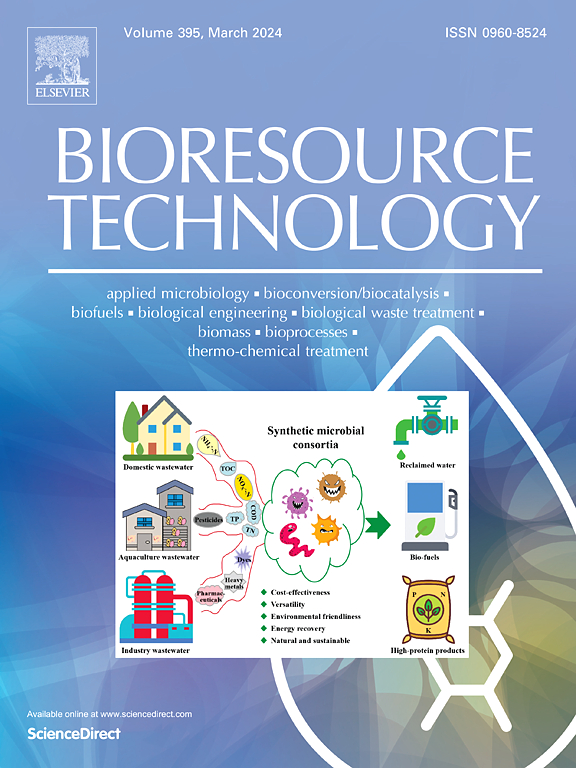野油菜黄单胞菌通过促进黄原胶单体的生物合成来提高黄原胶的产量。
IF 9.7
1区 环境科学与生态学
Q1 AGRICULTURAL ENGINEERING
引用次数: 0
摘要
目前,提高黄单胞菌黄原胶(XG)产量的工作主要集中在生长介质、操作参数和下游步骤上。然而,一个关键的方面是开发最佳菌株。本研究旨在利用动力学和化学计量学模型研究XG单体的形成,找出可能存在的瓶颈,并设计重组菌株以克服这些限制。在野油菜黄单胞菌(Xanthomonas campestris pv. campestris)中过表达了参与 UDP-葡萄糖和 UDP-葡萄糖醛酸单体生物合成的 galU 和 ugd 基因。菌株在摇瓶和生物反应器中培养。正如硅学分析所预测的那样,ugd 基因的过表达导致树胶合成量显著增加,生物反应器中的体积生产率提高了 50%。在较小程度上,galU 的过表达也改善了产品的形成。这些发现验证了单体生物合成代谢工程可提高 XG 产量的假设。本文章由计算机程序翻译,如有差异,请以英文原文为准。

Xanthan gum production in Xanthomonas campestris is increased by favoring the biosynthesis of its monomers
Current efforts to improve xanthan gum (XG) production by Xanthomonas have focused on the growth medium, operating parameters, and downstream steps. However, a key aspect is the development of optimal strains. The present work aimed to investigate the formation of XG monomers, using kinetic and stoichiometric models to identify possible bottlenecks, and to engineer a recombinant strain to overcome such limitations. The galU and ugd genes involved in the biosynthesis of the UDP-glucose and UDP-glucuronic acid monomers were overexpressed in Xanthomonas campestris pv. campestris. The strains were cultivated in shake flasks and bioreactor. As predicted by in silico analysis, overexpression of the ugd gene resulted in a significant increase in gum synthesis, up to 50% higher volumetric productivity in the bioreactor. To a lesser extent, galU overexpression was also shown to improve product formation. These findings validated the hypothesis that metabolic engineering of the monomer biosynthesis can enhance XG production.
求助全文
通过发布文献求助,成功后即可免费获取论文全文。
去求助
来源期刊

Bioresource Technology
工程技术-能源与燃料
CiteScore
20.80
自引率
19.30%
发文量
2013
审稿时长
12 days
期刊介绍:
Bioresource Technology publishes original articles, review articles, case studies, and short communications covering the fundamentals, applications, and management of bioresource technology. The journal seeks to advance and disseminate knowledge across various areas related to biomass, biological waste treatment, bioenergy, biotransformations, bioresource systems analysis, and associated conversion or production technologies.
Topics include:
• Biofuels: liquid and gaseous biofuels production, modeling and economics
• Bioprocesses and bioproducts: biocatalysis and fermentations
• Biomass and feedstocks utilization: bioconversion of agro-industrial residues
• Environmental protection: biological waste treatment
• Thermochemical conversion of biomass: combustion, pyrolysis, gasification, catalysis.
 求助内容:
求助内容: 应助结果提醒方式:
应助结果提醒方式:


